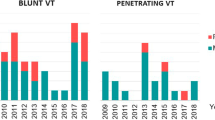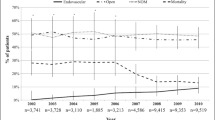Abstract
Background
The aim was to study the nature of iatrogenic vascular injuries (IVIs) associated with postoperative death within 30 days.
Methods
Patients who had undergone vascular surgery for IVIs and were reported prospectively to the Swedish national vascular registry during 1987–2008 were identified. They were cross-checked with the national population registry. Those who died within 30 days of surgery were studied regarding case records and death certificates.
Results
A total of 56 patients with postoperative death within 30 days after IVI were identified. Among them, 52 case records were retrieved (93 %). In 24 cases the IVIs were caused by puncture during endovascular procedures (13 hemorrhage, 11 occlusive thrombosis), 11 by penetrating trauma during open surgery, 6 by occlusion after external compression, 6 by percutaneous accidental arterial puncture. Main symptoms were peripheral ischemia (19/52, 37 %), external bleeding (14, 27 %), and hypovolemic shock without external bleeding (10, 19 %). Main specialties involved were interventional radiology (n = 18), general surgery (n = 9), and interventional cardiology (n = 8). Overall, 22 (42 %) were avoidable, and only 13 (25 %) underwent autopsy. Within 2 weeks, 36 patients (69 %) were dead. Also, there was a higher proportion with uncertain correlation between IVI and death.
Conclusions
Interventional radiology, general surgery, and cardiology are the main specialities involved in IVIs with lethal outcome. Not all fatalities after IVI are attributable to the injury itself, but almost half of the injuries were considered avoidable.


Similar content being viewed by others
References
Bergqvist D, Jonsson K, Weibull H (1987) An analysis of complications to percutaneous transluminal angioplasty of extremity and renal arteries. Acta Radiol 28:3–12
Lazarides MK, Tsoupanos S, Georgopoulos S et al (1998) Incidence and patterns of iatrogenic arterial injuries. A decade’s experience. J Cardiovasc Surg 39:281–285
Giswold M, Landry G, Taylor L et al (2004) Iatrogenic arterial injury is an increasingly important cause of arterial trauma. Am J Surg 187:590–593
Smith T (1993) Perioperative deaths: detection by linkage of hospital discharge and death registration sub-files. Health Bull (Edinb) 51:299–309
Russell EM, Bruce J, Krukowski ZH (2003) Systematic review of the quality of surgical mortality monitoring. Br J Surg 90:527–532
Bruce J, Russell EM, Mollison J (2001) The measurement and monitoring of surgical adverse events. Health Technol Assess 5:1–194
Rudström H, Bergqvist D, Ögren M et al (2008) Iatrogenic vascular injuries in Sweden: a nationwide study 1987–2005. Eur J Vasc Endovasc Surg 35:131–138
Bergqvist D, Troëng T, Elfström J et al (1998) Auditing surgical outcome: ten years with the Swedvasc. Eur J Surg 164(Suppl):581
Troeng T, Malmstedt J, Björck M (2008) External validation of the Swedvasc registry: a first-time individual cross matching with the unique personal identity number. Eur J Vasc Endovasc Surg 36:705–712
Osswald BR, Blackstone EH, Tochtermann U et al (1999) The meaning of early mortality after CABG. Eur J Cardiothorac Surg 15:401–407
Johnsson ML, Gordon FL, Petersen NJ et al (2002) Effect of definition of mortality on hospital profiles. Med Care 40:7–16
Mani K, Björck M, Wanhainen A (2013) Changes in the management of infrarenal abdominal aortic aneurysm disease in Sweden. Br J Surg 100:638–644
Goodwin H (2000) Litigation and surgical practice in the UK. Br J Surg 87:977–979
Vincent C, Moorthy K, Sarker S et al (2004) Systems approaches to surgical quality and safety, from concept to measurement. Ann Surg 239:475–482
Rudström H, Bergqvist D, Ahlberg J et al (2011) Insurance claims after vascular surgery in Sweden. Eur J Vasc Endovasc Surg 42:498–505
Oderich G, Panneton J, Hofer J et al (2004) Iatrogenic operative injuries of abdominal and pelvic veins: a potentially lethal complication. J Vasc Surg 39:931–936
Mandolfino T, Canciglia A, Taranto F et al (2008) Outcome of iatrogenic injuries to the abdominal and pelvic veins. Surg Today 38:1009–1012
Mills JL, Wiedeman JE, Robison JG et al (1986) Minimizing mortality and morbidity from iatrogenic arterial injuries: the need for early recognition and prompt repair. J Vasc Surg 4:22–27
Segall N, Bonifacio AS, Schroeder RA et al (2012) Can we make postoperative patient handovers safer? A systematic review of the literature. Anesth Analg 115:102–115
Agarwal HS, Saville BR, Slayton JM et al (2012) Standardized postoperative handover process improves outcomes in the intensive care unit: a model for operational sustainability and improved team performance. Crit Care Med 40:2109–2115
Watanabe K, Yamazaki A, Hirano T et al (2010) Descending aortic injury by a thoracic pedicle screw during posterior reconstructive surgery. Spine 35:1064–1068
Hans S, Shepard AD, Reddy P et al (2011) Iatrogenic arterial injuries of spine and orthopedic operations. J Vasc Surg 53:407–413
Bingol H, Cingoz F, Yilmaz AT et al (2004) Vascular complications related to lumbar disc surgery. J Neurosurg 100(3 suppl Spine):249–253
Canaud L, Hireche K, Joyeux F et al (2011) Endovascular repair of aorto-iliac artery injuries after lumbar-spine surgery. Eur J Vasc Endovasc Surg 42:167–171
Rothwell P, Warlow C (1995) Is self-audit reliable? Lancet 346:1623
Acknowledgments
We thank all vascular and general surgeons and colleagues who generously and unconditionally provided data for this investigation. We are grateful to the Swedvasc Steering Committee (Björn Kragsterman, David Lindström, Ken Eliasson, Anders Lundell, Joakim Nordanstig, Jakob Hager, Erik Wellander) and the Maria Truedson Senior Advisory Board (David Bergqvist, Lars Norgren, Thomas Troëng). The Swedish Research Council supported this study (Grant K2010-65X-20406-04-3 to M.B.).
Conflict of interest
None.
Author information
Authors and Affiliations
Corresponding author
Appendix: cases 1, 2, and 3
Appendix: cases 1, 2, and 3
Case 1: vascular surgeon not attending first vascular repair of IVI
An 81-year-old man is undergoing reoperation due to residual rectal cancer. The preoperative computed tomography (CT) scan revealed a small aortoiliacal aneurysm. The sigmoid colon and ureters are adherent with ambient tissues. During the dissection there is a rift in the aneurysmatic left iliac artery. It is repaired with a continuous suture. There is no comment how hemostasis was achieved before and during suturing. There is no comment on pulses distal to the suture. After a lengthy operation, including Bricker deviation of the ureters, the patient is transferred to the intensive care unit (ICU).
Severe ischemia in the lower extremities develops during the night. Vascular surgeons are involved, and a bilateral aortoiliacal occlusion is diagnosed. At bilateral embolectomy from the groin the catheters cannot proceed more than 15 cm proximally into the aortoiliacal segment. An axillobifemoral bypass solves the inflow problem. At the end of the operation, after revascularization, the patient deteriorates and dies during the afternoon.
Comment: Failure to contact a specific competence for a specific iatrogenic injury is unacceptable. To achieve hemostasis and operate on an aneurysmatic vessel with thrombotic debris can be problematic. Completion control, including pulses in the groin after surgery, and continuous postoperative controls were not mentioned in the records. We did not have access to the nurse records of the ICU. Different record systems make analysis of adverse events difficult.
There was no autopsy. The cause of death written on the death certificate was aortoiliac thromboembolism, aortoiliac aneurysm (without rupture), and surgery for malignancy within 30 days. There was no code for iatrogenic injury.
Note: This would have been a missing case if only the database of diagnostic codes (ICD) had been scrutinized instead of a specialty register (Swedvasc).
Case 2: communication and reporting
A 33-year-old woman suffered from a lumbar disc hernia (L4-L5), with severe radiant pain and urinary retention. During the operation (dorsal approach) the blood pressure (BP) drops, but there is no visible bleeding. The BP is corrected with ephedrine injection. Poor urine production is partly corrected with mannitol infusion. At the end of the operation there is a change of anesthetist. Postoperatively, the patient has tachycardia and faints in the recovery room. Noninvasive BP is 110 mmHg. Initially, she is treated with an opioid inverse agonist and an acetylcholinesterase inhibitor. After recovery she is given β-blockers for the tachycardia. Shortly thereafter the patient’s condition deteriorates with weak peripheral pulses, a nondetectable noninvasive BP, and hemoglobin 78 g/L. She is transferred to the ICU where a central venous line in placed, and she is given intravenous fluids. There is still no visible external bleeding. The abdomen expands with the infusions. The surgeon on call takes the patient to the operation theater. There is a massive retroperitoneal hematoma, and both the right common iliac vein and artery are damaged near the aortic bifurcation. Hemostasis is achieved with clamps on the caval and both iliac veins and the aorta and right iliac artery. The defect on the iliac artery is repaired with a patch, and the iliac vein is sutured because of the massive bleeding and unstable circulation. Asystole appears at the end of the operation with no recovery. The patient dies.
Comment: Even though there were signs and suspicion of bleeding perioperatively, any worry about this possibility seems to have been missed during the many handovers and reports. The development is rather typical but because of its rarity was not considered a possible cause of death. There was no autopsy.
Case 3: selection of method and technical failure
A 73-year-old woman undergoes coronary angiography because of a recent percutaneous coronary intervention. Her history includes extensive vascular surgery with aortobifemoral bypass and bilateral femoropopliteal bypasses (below-knee right side and above-knee left side). The first puncture in the right groin goes subintimally, but puncture of the left side gives access. A FemoStop is placed on the right groin. During compression for hemostasis the right foot develops severe ischemia with pain, paresthesia, and paralysis. A vascular surgeon is called. The symptoms deteriorate rapidly despite no compression, and the clinical signs demand acute operation. Perioperative findings reveal thromboembolic occlusions due to the invasive manipulation and external compression including the right aortobifemoral graft limb, the profunda artery, and the right femoropopliteal graft. After a long operation with thromboembolectomy and patches plus deteriorated cardiac function, the inflow and profunda artery outflow is satisfactory, but the runoff to the foot is poor. Perioperative angiography shows no good distal foot artery for bypass. Because of irreversible ischemia, amputation above the right knee is performed 4 days later. The patient is transferred to a rehabilitation ward but deteriorates progressively. She dies 29 days after the IVI.
There was no autopsy. The cause of death on the death certificate was general arteriosclerosis, cardiac failure, and unspecified complications after more surgery.
Comment: Contact a vascular surgeon before choosing the access site and initiating interventions in patients with severe arteriosclerosis and multiple reconstructions with vascular grafts. Chose a noninvasive investigation or radial artery puncture for diagnostic angiography. If there is graft puncture, use a duplex-guided puncture followed by manual or duplex-guided compression. Conduct close checkups on the distal circulation after angiography.
Extended follow-up with linked registries helps identify transferred patients with late death after injury.
Rights and permissions
About this article
Cite this article
Rudström, H., Bergqvist, D. & Björck, M. Iatrogenic Vascular Injuries With Lethal Outcome. World J Surg 37, 1981–1987 (2013). https://doi.org/10.1007/s00268-013-2061-2
Published:
Issue Date:
DOI: https://doi.org/10.1007/s00268-013-2061-2




